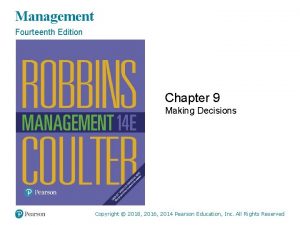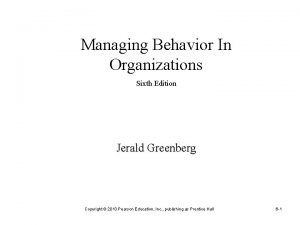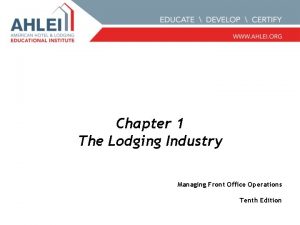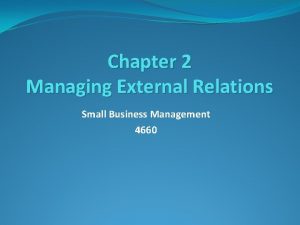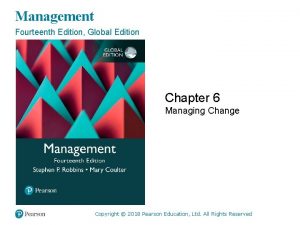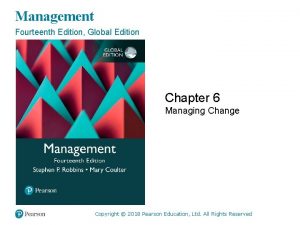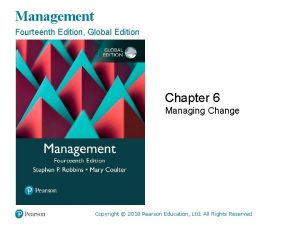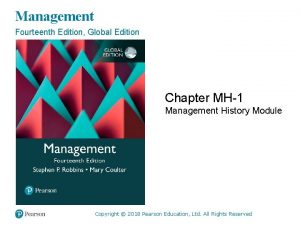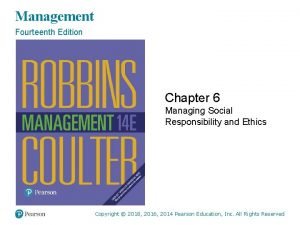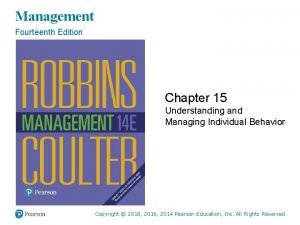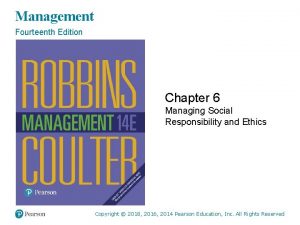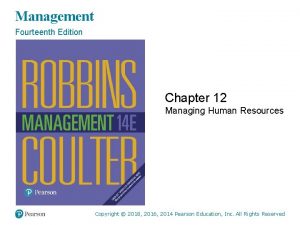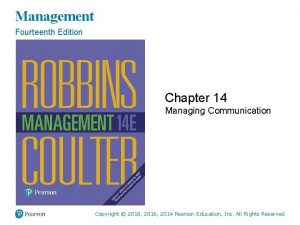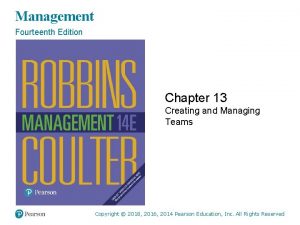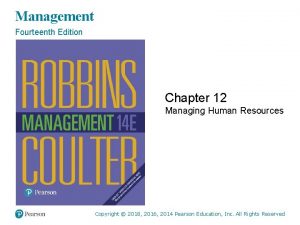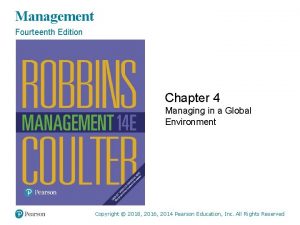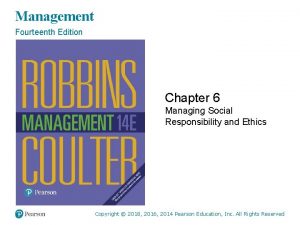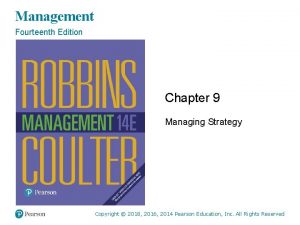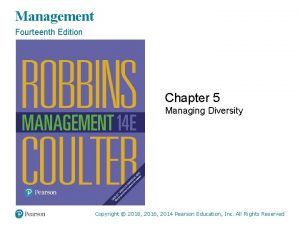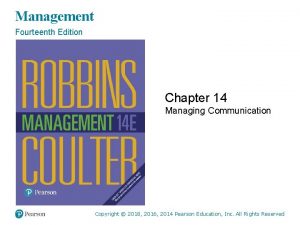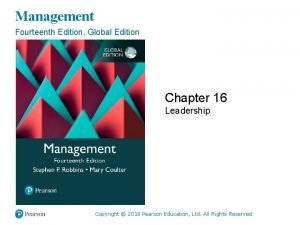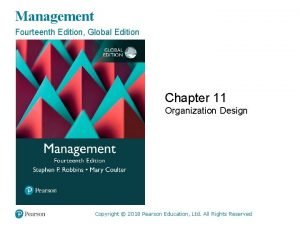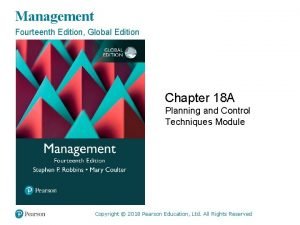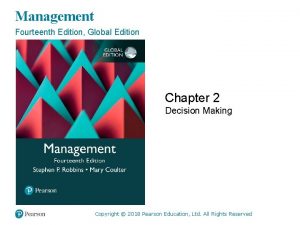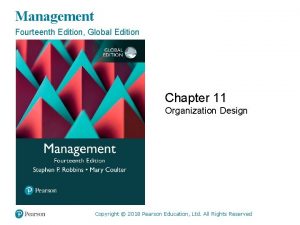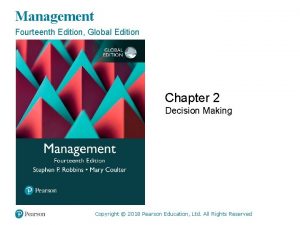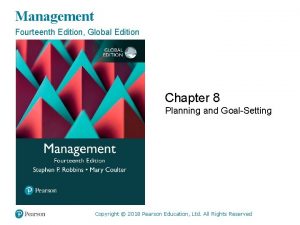Management Fourteenth Edition Chapter 3 Managing the External






































- Slides: 38

Management Fourteenth Edition Chapter 3 Managing the External Environment and the Organization’s Culture Copyright © 2018, 2016, 2014 Pearson Education, Inc. All Rights Reserved

Learning Objectives 3. 1 Contrast the actions of managers according to the omnipotent and symbolic views. 3. 2 Describe the constraints and challenges facing managers in today’s external environment. Develop your skill at scanning the environment so you can anticipate and interpret changes taking place. 3. 3 Discuss the characteristics and importance of organizational culture. Know how to read and assess an organization’s culture. 3. 4 Describe current issues in organizational culture. Copyright © 2018, 2016, 2014 Pearson Education, Inc. All Rights Reserved

The Manager: Omnipotent or Symbolic? • Omnipotent view: managers are directly responsible for an organization’s success or failure • Symbolic view: much of an organization’s success or failure is due to external forces outside managers’ control Copyright © 2018, 2016, 2014 Pearson Education, Inc. All Rights Reserved

Managerial Constraints • In reality, managers are neither all-powerful nor helpless. But their decisions and actions are constrained. • External constraints come from the organization’s environment and internal constraints come from the organization’s culture Copyright © 2018, 2016, 2014 Pearson Education, Inc. All Rights Reserved

Exhibit 3 -1 Constraints on Managerial Discretion Exhibit 3 -1 shows that external constraints come from the organization’s environment and internal constraints come from the organization’s culture. Copyright © 2018, 2016, 2014 Pearson Education, Inc. All Rights Reserved

The External Environment • Those factors and forces outside the organization that affect its performance – Economic – Demographic – Political/Legal – Sociocultural – Technological – Global Copyright © 2018, 2016, 2014 Pearson Education, Inc. All Rights Reserved

Exhibit 3 -2 Components of External Environment Exhibit 3 -2 shows the different components that make up the external environment. Copyright © 2018, 2016, 2014 Pearson Education, Inc. All Rights Reserved

The Economic Environment • Managers need to be aware of the economic context so they can make the best decisions for their organizations. Copyright © 2018, 2016, 2014 Pearson Education, Inc. All Rights Reserved

The Global Economy and the Economic Context • The lingering global economic challenges began with the turmoil in the U. S. housing market. Copyright © 2018, 2016, 2014 Pearson Education, Inc. All Rights Reserved

Economic Inequality and the Economic Context • Polls show that in many countries, people believe that the gap between the rich and poor is problematic. Copyright © 2018, 2016, 2014 Pearson Education, Inc. All Rights Reserved

The Demographic Environment • Age is a particularly important demographic since the workplace often has different age groups all working together – Baby Boomers – Gen Y (Millennials) – Post-Millennials Copyright © 2018, 2016, 2014 Pearson Education, Inc. All Rights Reserved

Gen Y is an important demographic at Facebook, where most employees are under 40. Copyright © 2018, 2016, 2014 Pearson Education, Inc. All Rights Reserved

How the External Environment Affects Managers • Jobs and Employment: the impact of external factors on jobs and employment is one of the most powerful constraints mangers face Copyright © 2018, 2016, 2014 Pearson Education, Inc. All Rights Reserved

Assessing Environmental Uncertainty • Environmental uncertainty: the degree of change and complexity in an organization’s environment – Change: stable to dynamic – Complexity: simple to complex Copyright © 2018, 2016, 2014 Pearson Education, Inc. All Rights Reserved

Exhibit 3 -3 Environmental Uncertainty Matrix Exhibit 3 -3 shows the two aspects of environmental uncertainty, change and complexity. Copyright © 2018, 2016, 2014 Pearson Education, Inc. All Rights Reserved

Managing Stakeholder Relationships • Stakeholders: any constituencies in the organization’s environment that are affected by an organization’s decisions and actions Copyright © 2018, 2016, 2014 Pearson Education, Inc. All Rights Reserved

Exhibit 3 -4 Organizational Stakeholders Exhibit 3 -4 identifies some of an organization’s most common stakeholders Copyright © 2018, 2016, 2014 Pearson Education, Inc. All Rights Reserved

Benefits of Good Stakeholder Relationships • Improved predictability of environmental changes • Increased successful innovations • Increased trust among stakeholders • Greater organizational flexibility to reduce the impact of change Copyright © 2018, 2016, 2014 Pearson Education, Inc. All Rights Reserved

Organizational Culture • Just as each individual has a unique personality, an organization, too, has a personality. Copyright © 2018, 2016, 2014 Pearson Education, Inc. All Rights Reserved

What is Organizational Culture? • Organizational culture: the shared values, principles, traditions, and ways of doing things that influence the way organizational members act and that distinguish the organization from other organizations Copyright © 2018, 2016, 2014 Pearson Education, Inc. All Rights Reserved

Exhibit 3 -5 Dimensions of Organizational Culture Exhibit 3 -5 identifies the seven dimensions of organizational culture. Copyright © 2018, 2016, 2014 Pearson Education, Inc. All Rights Reserved

Contrasting Organizational Culture • At Tesla Motors, the focus is product innovation (innovation and risk taking). • In contrast, Southwest Airlines has made its employees a central part of its culture. Copyright © 2018, 2016, 2014 Pearson Education, Inc. All Rights Reserved

Exhibit 3 -6 Contrasting Organizational Culture • Risk-taking and change discouraged • Creativity discouraged • Close managerial supervision • Work designed around individual employees • Risk-taking and change rewarded • Creativity and innovation rewarded • Management trusts employees • Work designed around teams Copyright © 2018, 2016, 2014 Pearson Education, Inc. All Rights Reserved

Strong Cultures • Strong cultures: organizational cultures in which the key values are intensely held and widely shared Copyright © 2018, 2016, 2014 Pearson Education, Inc. All Rights Reserved

Exhibit 3 -7 Strong Versus Weak Cultures Strong Cultures Weak Cultures Values widely shared Values limited to a few people – usually top management Culture conveys consistent messages about what’s important Culture sends contradictory messages about what’s important Most employees can tell stories about company history or heroes Employees have little knowledge of company history or heroes Employees strongly identify with culture Employees have little identification with culture Strong connection between shared values and behaviors Little connection between shared values and behaviors Copyright © 2018, 2016, 2014 Pearson Education, Inc. All Rights Reserved

Where Culture Comes From and How it Continues • The original source of the culture usually reflects the vision of the founders. • Once the culture is in place, certain organizational practices help maintain it. • The actions of top managers also have a major impact on the organization’s culture. Copyright © 2018, 2016, 2014 Pearson Education, Inc. All Rights Reserved

Exhibit 3 -8 Establishing and Maintaining Culture Exhibit 3 -8 illustrates how an organization’s culture is established and maintained. Copyright © 2018, 2016, 2014 Pearson Education, Inc. All Rights Reserved

How Employees Learn Culture • Stories • Rituals • Material Artifacts and Symbols • Language Copyright © 2018, 2016, 2014 Pearson Education, Inc. All Rights Reserved

How Culture Affects Managers • Because an organization’s culture constrains what they can and cannot do and how they manage, it’s particularly relevant to managers. Copyright © 2018, 2016, 2014 Pearson Education, Inc. All Rights Reserved

Exhibit 3 -9 Types of Managerial Decisions Affected by Culture As shown in Exhibit 3 -9, a manager’s decisions are influenced by the culture in which he or she operates. Copyright © 2018, 2016, 2014 Pearson Education, Inc. All Rights Reserved

Creating an Innovative Culture • Challenge and involvement • Freedom • Trust and openness • Idea time • Playfulness/humor • Conflict resolution • Debates • Risk taking Copyright © 2018, 2016, 2014 Pearson Education, Inc. All Rights Reserved

Exhibit 3 -10 Creating a Customer Responsive Culture Characteristics of Customer Responsive Culture Suggestions for Managers Type of employee Hire people with personalities and attitudes consistent with customer service: friendly, attentive, enthusiastic, patient, good listening skills Type of job environment Design jobs so employees have as much control as possible to satisfy customers, without rigid rules and procedures Empowerment Give service-contact employees the discretion to make day-today decisions on job-related activities Role clarity Reduce uncertainty about what service-contact employees can and cannot do by continual training on product knowledge, listening, and other behavioral skills Consistent desire to satisfy and delight customers Clarify organization’s commitment to do whatever it takes, even if it’s outside an employee’s normal job requirements Copyright © 2018, 2016, 2014 Pearson Education, Inc. All Rights Reserved

Creating a Sustainability Culture • For many companies, sustainability is developed into the organization’s overall culture. Copyright © 2018, 2016, 2014 Pearson Education, Inc. All Rights Reserved

Review Learning Objective 3. 1 • Contrast the actions of managers according to the omnipotent and symbolic views. – Omnipotent view: Managers are directly responsible for the organization’s success or failure. – Symbolic view: Much of the organization’s success or failure is due to external forces outside of the manager’s control. – The two constraints on managers' discretion are organizational culture (internal) and the environment (external). Copyright © 2018, 2016, 2014 Pearson Education, Inc. All Rights Reserved

Review Learning Objective 3. 2 • Describe the constraints and challenges facing managers in today’s external environment. – The external environment includes those factors and forces outside the organization that affect its performance). – The main components of the external environment are economic, demographic, political/legal, sociocultural, technological, and global. – These components can constrain and challenge managers because they have an impact on jobs, environmental uncertainty, and stakeholder relationships. Copyright © 2018, 2016, 2014 Pearson Education, Inc. All Rights Reserved

Review Learning Objective 3. 3 • Discuss the characteristics and importance of organizational culture. – The seven dimensions of culture are: attention to detail, outcome orientation, people orientation, team orientation, aggressiveness, stability, innovation, and risk taking. – The stronger the culture, the greater the impact on the way managers plan, organize, lead, and control. – The original source of the organizational culture reflects the founder’s vision. – Culture is transmitted through stories, rituals, material symbols, and language. Copyright © 2018, 2016, 2014 Pearson Education, Inc. All Rights Reserved

Review Learning Objective 3. 4 • Describe current issues in organizational culture. – The characteristics of an innovative culture are challenge and involvement, freedom, trust and openness, idea time, playfulness/humor, conflict resolution, debates, and risk taking. – A customer responsive culture has five characteristics: outgoing and friendly employees; jobs with few rigid rules, procedures, and regulations; empowerment; clear roles and expectations; and employees who are conscientious in their desire to please the customer. – Companies that achieve business goals and increase long-term share-holder value by integrating economic, environmental, and social opportunities into business strategies may develop sustainability into the organization’s overall culture. Copyright © 2018, 2016, 2014 Pearson Education, Inc. All Rights Reserved

Copyright © 2018, 2016, 2014 Pearson Education, Inc. All Rights Reserved
 Management fourteenth edition
Management fourteenth edition Fourteenth amendment
Fourteenth amendment Summer sun poem
Summer sun poem Managing behavior in organizations 6th edition
Managing behavior in organizations 6th edition Managing front office operations 10th edition
Managing front office operations 10th edition Small business management
Small business management Using mis (10th edition) 10th edition
Using mis (10th edition) 10th edition Chapter 1
Chapter 1 External-external trips
External-external trips Principles of management stephen p robbins
Principles of management stephen p robbins Hát kết hợp bộ gõ cơ thể
Hát kết hợp bộ gõ cơ thể Ng-html
Ng-html Bổ thể
Bổ thể Tỉ lệ cơ thể trẻ em
Tỉ lệ cơ thể trẻ em Chó sói
Chó sói Chụp tư thế worms-breton
Chụp tư thế worms-breton Hát lên người ơi alleluia
Hát lên người ơi alleluia Kể tên các môn thể thao
Kể tên các môn thể thao Thế nào là hệ số cao nhất
Thế nào là hệ số cao nhất Các châu lục và đại dương trên thế giới
Các châu lục và đại dương trên thế giới Cong thức tính động năng
Cong thức tính động năng Trời xanh đây là của chúng ta thể thơ
Trời xanh đây là của chúng ta thể thơ Cách giải mật thư tọa độ
Cách giải mật thư tọa độ 101012 bằng
101012 bằng Phản ứng thế ankan
Phản ứng thế ankan Các châu lục và đại dương trên thế giới
Các châu lục và đại dương trên thế giới Thể thơ truyền thống
Thể thơ truyền thống Quá trình desamine hóa có thể tạo ra
Quá trình desamine hóa có thể tạo ra Một số thể thơ truyền thống
Một số thể thơ truyền thống Cái miệng nó xinh thế
Cái miệng nó xinh thế Vẽ hình chiếu vuông góc của vật thể sau
Vẽ hình chiếu vuông góc của vật thể sau Thế nào là sự mỏi cơ
Thế nào là sự mỏi cơ đặc điểm cơ thể của người tối cổ
đặc điểm cơ thể của người tối cổ Ví dụ giọng cùng tên
Ví dụ giọng cùng tên Vẽ hình chiếu đứng bằng cạnh của vật thể
Vẽ hình chiếu đứng bằng cạnh của vật thể Tia chieu sa te
Tia chieu sa te Thẻ vin
Thẻ vin đại từ thay thế
đại từ thay thế điện thế nghỉ
điện thế nghỉ
